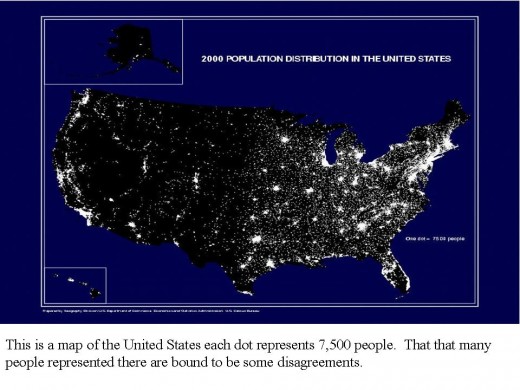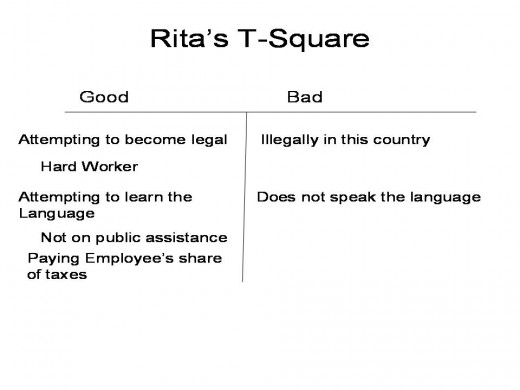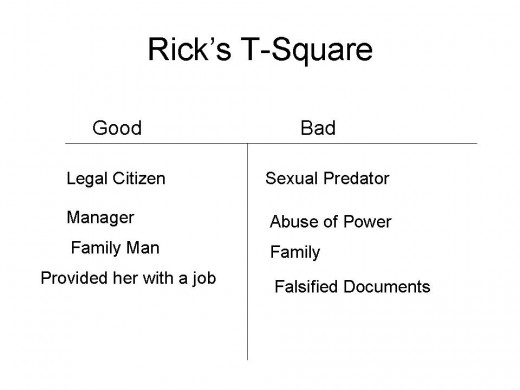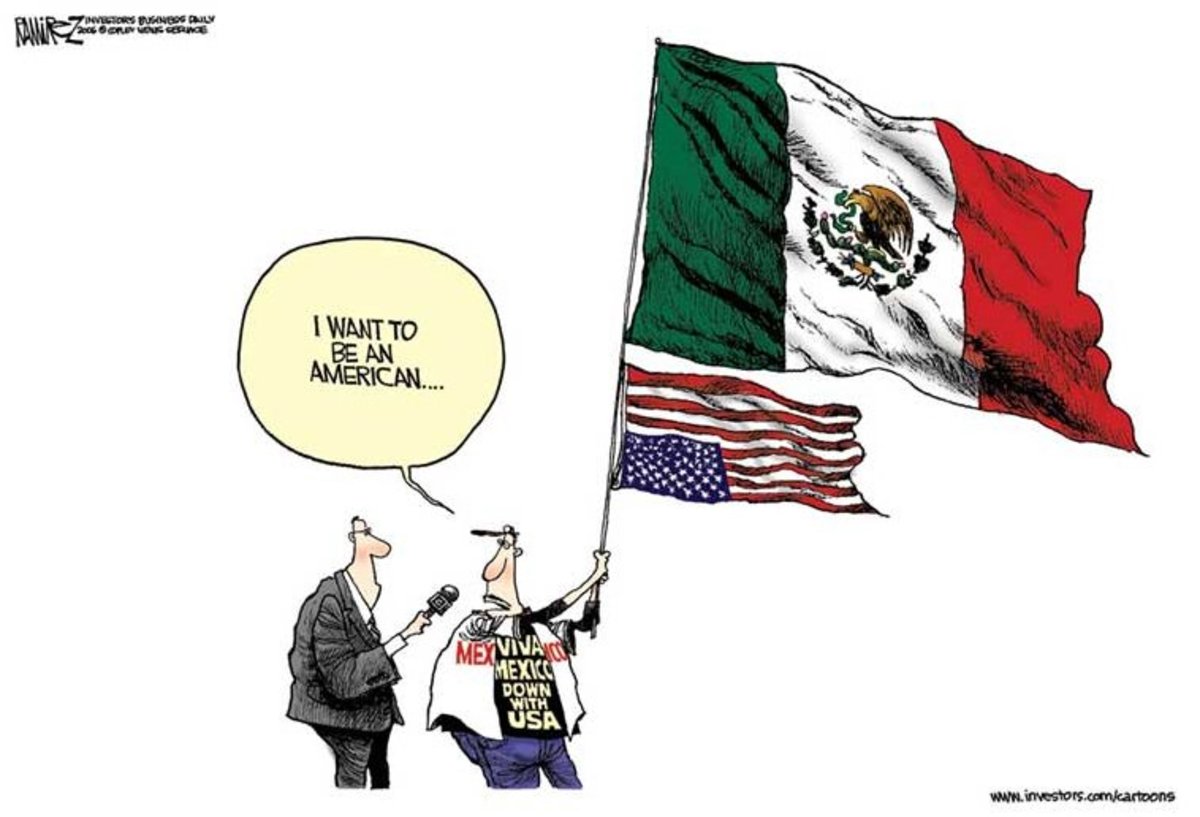Immigration Part Two: What is the Greater Good
Figure 1

Immigration Part Two: What is the Greater Good©
Mark Monroe
December 20, 2011
I am not under any delusion that would lead me to believe that humans, in their current state of evolution, could ever create a law or set of laws that is fair to all. The census map in Figure 1[1] depicts the distribution of the population in the United States. Each dot represents 7,500 different points of view and the diversity of thought that resides in this country. The quantity of people alone makes it unreasonable to assume that their needs will not come into conflict with each other. A society, such as we claim to be, in order to survive, has to devise a balance between the competing needs. Thomas Jefferson spoke of this balance "All too will bear in mind this sacred principle, that though the will of the majority is in all cases to prevail, that will, to be rightful, must be reasonable; that the minority possess their equal rights, which equal laws must protect, and to violate would be oppression." --Thomas Jefferson: 1st Inaugural, 1801. ME 3:318[2].
However, even the most rational, well planned, and carefully crafted statute will leave someone behind [3]. I also understand that there are times when we have to look at the greater good when implementing or administering the intent of a law. With that in mind a society has to be willing to compromise when laws and needs of the individual come into conflict with each other. A society has to understand that the greater good may come about by initially helping only one person. Often the greater good for a society is not the first thing that the society sees. Especially when all the society can see is the flash and bang of the media. Even if the society does see the right path, the right answer and doing the right thing is not always the easiest path to follow.
The following is a tale about a woman, for the purposes of this chapter I will call her Rita[4]. Rita is in her middle thirties and the single mother of two children, ages 10 and 14. She was born and raised in a small village in southern Mexico. Due to the living conditions of her hometown and despite the fact she does not know how to speak English; she takes a chance and moves her family to America. Unfortunately her station and economic condition are such that she does not have access to the means[5] to legally immigrate to America. By finding an alternative method for entry, she also understands the position this puts her in. For a chance at a better life for her children, she is willing to risk it.
It is at this point in the story where many people will stop listening, and form an opinion of Rita, because of the mental roadblock to understanding that they may encounter. This blockage here is based solely on her immigration status in this country. They do not want to hear another story about someone who in their mind should not be here in the first place. To understand how this story relates to the greater good I would encourage you to continue reading. As Paul Harvey[6] used to say, “Now, the Rest of the Story”.
When she first arrives in Texas, Rita has trouble finding employment and her immediate prospects for a better life appear to be dim. That was until she met a man named Rick[7]. Rick was a shift manager for a local branch of a national company. Rick told Rita that he would be able to get her a job working part time on the swing shift that he supervised. The shift would include Rita and about eight (8) other employees (both male and female). As it turns out Rita, except for Rick, was the only Spanish-speaking employee. The rest of the employees on that shift only spoke English. It just so happens that about six months before Rita was hired Rick had hired another Spanish-speaking woman in the position that Rita had. That woman worked for Rick only about two months and then left unexpectedly.
Due to the size and location of the operation there was no onsite Human Resources presence. Each manager was responsible for completing all new hire paperwork for each employee. Then they would file the forms in the personnel files. The manager would complete the process by sending the appropriate copies and information to the regional office for payroll processing. It was well known that the regional management office for the company did not make it a habit of checking the personnel files of the local branches. The company was more concerned about the profit/loss information for each branch. Due to this corporate practice, Rick was able to help Rita complete the paperwork and provided to her the Social Security Number to use on the work authorization forms. All was well.
For once, Rita thought that she had caught a break. She was able to secure a job that paid her well ($8.50 an hour). She was finally able to start to give her children a chance at a better life than she had in her home village. Rita had proved herself to be a hard and effective worker. Within a couple of months she had earned herself a merit increase from Rick’s boss and she was brought on full time, granted a 40-hour schedule, and she received health care benefits. With the raise she was able to put some money aside to hire a lawyer that told her he would help her secure her citizenship. It was her ultimate goal to be a citizen so her children could get a good education.
It was shortly after she received her raise when things started to change at work. At first Rick would come up to her and tell her that she owed him for all the trouble that he had gone through for her. Since no one else in the work area spoke Spanish, no one knew exactly what Rick was telling her. For the casual observer it would have appeared as if he was just giving her instruction like the one he had done a hundred times before, there was no outward appearance of anything else going on. But, he would not pursue the matter; he would just tell her she owed him and then move along.
After a few weeks of this, Rick’s behavior became more aggressive. He began telling her how sexy she was looking and that he bet that she looked great in the nude. Again, to the other employees in the kitchen they could not see any outward sign of anything going on. All Rick would do is walk up to Rita, tell her a few things and then move on.
Then one day Rick shows up at Rita’s house. He tells her that it soon will be time for her to start repaying him for everything that he has done for her. The form of repayment he was looking for was a sexual relationship. She would meet him anytime he wanted her too. If he did not receive her cooperation in this matter, then he was not sure how long it would be before Homeland Security, Immigration Service found out about her. Rick began to feel comfortable around Rita and his action became even bolder. It got to the point that he would reach inside of her shirt and fondle her breasts at work whenever the two were alone.
Instead of continuing this relationship and working in the environment that she was in, Rita ends up quitting her job and melts into the West Texas background. It was at this time she found out that the lawyer she had been paying was deceiving her. Instead of helping her file the proper paperwork to legalize her status in this country, he claimed that the money she was paying him was for his legal advice that she had to work the immigration paperwork through the system herself.
After Rita left, the regional office decided to audit the personnel practices at the location. They were starting to see a pattern of Hispanic women working for about three (3) months before they left. It was discovered the new hire paperwork on these women was also suspect. When Rick was questioned by his management about the reasons why Rita and the other Hispanic females left the company and the why their new hire paperwork was questionable, he found himself another job in a different part of the state and left with no notice. The company in question really gave the situation no further thought, all parties involved were gone and they (the company) technically had done nothing wrong. They had a problem with their hiring process and documentation, which was fixed. The manager that may have done something wrong had left, as did the employee with questionable work authorization paperwork. The employer was under no obligation to report either incident to the authorities. They had no proof of wrongdoing by the manager and they do not have to report an employee with questionable paperwork.
Discovering an Unauthorized Employee
An employer who discovers that an employee has been working without authorization should reverify work authorization by allowing such an employee another opportunity to present acceptable documentation and complete a new Form I-9. However, employers should be aware that, if they know or should have known that an employee is unauthorized to work in the United States, they may be subject to serious penalties for “knowingly continuing to employ” an unauthorized worker.[8]
In looking at the events as they happened I am, going to try to avoid some of the emotional pitfalls associated with such discussions. The events that I presented are not a simple matter to understand, as some would like to first believe. Here are some points of the scenario that should be considered:
1) She (Rita) entered into this country illegally.
2) She had taken active, no matter how futile, steps to correct her immigration status.
3) She was a hard worker and a good employee.
4) The company she was working for was deducting the appropriate payroll taxes.
5) While she was employed, she was not receiving any public assistance.
6) A sexual predator set upon her.
7) She was deceived or mislead by legal council.
8) She had no agency or person that she felt that she could report her story too.
Where is the greater good for this country served in this case? I ask that question because there are several sets of laws (Immigration, employment, IRS code and anti-discrimination statutes) that come into conflict with each other. Even if you asked the question as a moral issue there are still several competing answers that would be morally correct and completely opposite. To tell you the truth I am not completely sure that I know the correct answer, but the debate has to happen because what is in the balance are basic human rights and our founding principles and ideas.
Where is the greater good for this country served? Is it best served by sending back to Mexico a hard working person who wants to be a productive member of our society or by letting a person with very questionable motives continues to prey on people? Yes, I understand that the last statement was an emotionally charged statement and that I said I would try and stay away from the tactic. But the fact of the matter is in a case such as this, I think that our national priorities in this case are misplaced. The majority of people reading this article will focus only on the fact that she came across the border illegally. As such they believe she is not entitled to the same protections and rights as a citizen.
When people hold this belief they should consider that they are labeling her less than human. The same way that Rick (the sexual predator) had labeled her less than human. Some would retort that they would send her back to Mexico and go after Rick. They would find his actions morally reprehensible. My come back to that would be, “How”? How would you find out? The victim in this case would not be compelled to come forward if she knew that she would lose what little she already has.
Here are some reasons why she would not report the incident to the authorities.
1) According to the Department of Justice, only 36%[9] of sexual assaults are reported; the reasons for not reporting are varied. With the group of women who are in Rita’s situation, you add the extra fear of deportation and you will find very few women willing to bring it forward.
2) Remember that in the area of Mexico that she came from, the police and the government did not have the best relationship with its citizens.
3) This incident is related to her work environment. She would have a hard time finding a law enforcement agency that would pursue an issue that they perceive as a violation of tort or civil law[10]. Coerced sex not related to work is called rape, when it is related to the work environment it is called sexual harassment.


What is the greater good? Is it fixing Rick because his impact continues for all employees he touches. He also affects all the companies that he is employed by; productive, staffing and retention are just some of the issues associated with him. While Rita on the other hand, what is the impact if she is allowed to stay in America and get her citizenship? What is the correct answer? I do not know. Again, you have to ask yourself where the greater good for the country lies. Could it be that the greater good is served by protecting the interests of the individual? One way to look at this problem is to use a method that was introduced by John Mill in the 1860’s. He was able to devise a system of checks and balances that any accountant would approve of; referred to as utilitarianism. Richard De George explains the basic action of utilitarianism, “According to utilitarianism, we should evaluate an action by looking at its consequences, weighing the good effects against the bad effects on all the people affected by it.”[11] Mr. Mill’s designed a theory where a person can systematically evaluate the consequences of an action. One aspect about his method that I like is that it forces the evaluation of more than one point of view. While this does not eliminate personal basis from the equation, it provides the opportunity for competing thought to be exposed.
The basic design of this method is to first create a T square for the different alternatives, in this case Rita (Figure 2) and Rick (Figure 3). Then you fill in the each T with positive and negative points depending on the situation. I am just quickly skimming over the points as I build my T’s but I would argue that in this instance the greater good in this case is served in helping Rita and going after Rick. Rita, even though she is not legal, she is still paying for her share employment taxes, which were taken out of her paycheck every week. For those who want to argue that she took a job away from a legal resident, I would like to point out that it took the business months to replace her because of the type of work and wages being offered no one in the area wanted the job.
Some would like to look at Rick and Rita’s situation as separate issues to be evaluated in a vacuum. In this case, the two cannot be separated because Rick’s actions in part are facilitated by Rita’s immigrations status. That is not to say that if Rita were not there Rick would not act the same with someone else. In fact, studies show that more than likely Rick has done this sort of thing before, and Rita was just a current target of opportunity.
What is the process for becoming a naturalized citizen? The following steps are off the U.S. Immigration site.
Eligibility Requirements
- If you are a green card holder of at least 5 years, you must meet the following requirements in order to apply for naturalization:
- Be 18 or older
- Be a green card holder for at least 5 years immediately preceding the date of filing the Form N-400, Application for Naturalization
- Have lived within the state, or USCIS district with jurisdiction over the applicant’s place of residence, for at least 3 months prior to the date of filing the application
- Have continuous residence in the United States as a green card holder for at least 5 years immediately preceding the date of the filing the application
- Be physically present in the United States for at least 30 months out of the 5 years immediately preceding the date of filing the application
- Reside continuously within the United States from the date of application for naturalization up to the time of naturalization
- Be able to read, write, and speak English and have knowledge and an understanding of U.S. history and government (civics)
- Be a person of good moral character, attached to the principles of the Constitution of the United States, and well disposed to the good order and happiness of the United States during all relevant periods under the law.[12]
What would prevent Rita from applying? Right now, there are very few ways for a person who has entered into this country illegally to gain citizenship. I am not trying to be a self-proclaimed immigration expert, but I am trying to present information that this issue is not as clear-cut as it may appear to people. There has to be a balance between objectives that provide a safe and productive environment for this country. In this example, the threat to our security and productivity is not Rita, it is Rick. I leave you with the question of, how do we address that?
Footnotes
[1] 2000 US Census Population Distribution. http://www.census.gov/geo/www/mapGallery/2kpopden.html. (accessed December 20, 2011)
[2] III. First Inaugural Address. The Papers of Thomas Jefferson, Volume 33: 17 February to 30 April 1801. (PrincetonUniversity Press, 2006), 148-52. http://www.princeton.edu/~tjpapers/inaugural/infinal.html. (accessed December 20, 2011)
[3] Even if the legislative branch could create the perfect, the lawyers would muck it up soon enough.
[4] Not her real name
[5] Money
[6] The reference is to Paul Harvey ABC Radio News Commentator, who had a news segment called, The Rest of the Story
[7] Not his real name
[8] U.S. DEPARTMENT OF HOMELAND SECURITY, U.S. CITIZENSHIP AND IMMIGRATION SERVICES. Employer Information Bulletin 102. The Form I-9 Process In A Nutshell. October 7, 2005. http://www.uscis.gov/files/article/EIB102.pdf. (accessed December 20, 2011)
[9] Department of Justice,Office of Justice Programs, Bureau of Justice Statistics: Selected Findings. Rape and Sexual Assault: Reporting to Police and Medical Attention, 1992-2000. August 2002, NCJ 194530
[10] In simple terms there are basically two types of laws, criminal and tort (civil). Criminal violations can land you in jail; tort can land you in a lawsuit.
[11] DeGeorge, Richard. Business Ethics Fourth Edition. Page 62
[12] U.S. Citizenship and Immigration Service. Path to U.S. Citizenship. http://www.uscis.gov/ (accessed November 03, 2012)
© 2011 Mark Monroe









